6-5-4
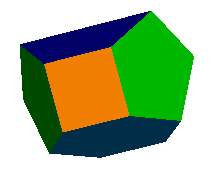
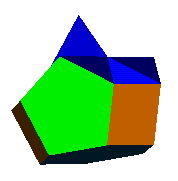
The minimal 6-5-4 acrohedron (20
faces) imaged above left
was discovered by Professor John Conway. It was the result of a specific
search for a solution for the 6-5-4 acron. It is notable in
that it contains a number of coplanar faces. These can be removed
by the addition of four additional tetrahedra.
The result is imaged above right (28 faces). For the semi-hexagonal faces, the
tetrahedra must face inwards to avoid further coplanarity problems. Note, the coplanar figure is
mentioned in passing in Professor Bonnie Stewart's "Adventures Among the
Toroids" (2nd Edition page 168), where it receives the name W'.
In this case it is a transitional phase in the generation of a triangular
hebesphenorotunda
from a tri-diminished icosahedron.
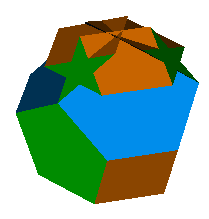
The minimal non-coplanar case can be
improved upon if we permit self-intersection. Dr Richard Klitzing has studied the
facets of the rhombidodecadodecahedron, amongst
which was the above 17-faced figure.
Dr Klitzing informs me that he has to date only studied facets with a three-fold
or five-fold
symmetry, so this result may still be improved upon. (Note, the previous
example of a 21-faced polyhedron with five-fold symmetry is linked here)
The full results of Dr Klitzing's work
on faceting a number of the uniform polyhedra are
hosted by Ulrich Mikloweit here.
6-5-3-3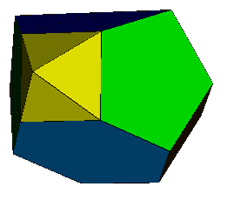
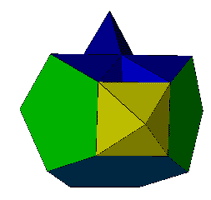
The minimal 6-5-3-3 acrohedron (23
faces) imaged above left
was discovered in 2005 by Alex Doskey, it is formed by augmenting one of the square
faces in Professor John Conway's 6-5-4 acrohedron with
a square pyramid. It does though retain the coplanar faces of the original
figure. These can be removed
by the addition of four additional tetrahedra.
The result is imaged above right (31 faces). For the semi-hexagonal faces, the
tetrahedra must face inwards to avoid further coplanarity problems.
In both cases the augmented faces are highlighted.
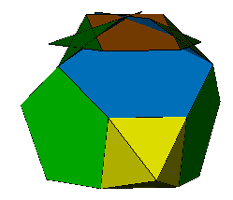
Again the minimal non-coplanar case can be
improved upon if we permit self-intersection. If we perform a similar
augmentation to Dr Richard Klitzing's rhombidodecadodecahedron
facet, we can obtain the above 20-faced figure.
The augmented faces are highlighted.
Back: to acrohedra





